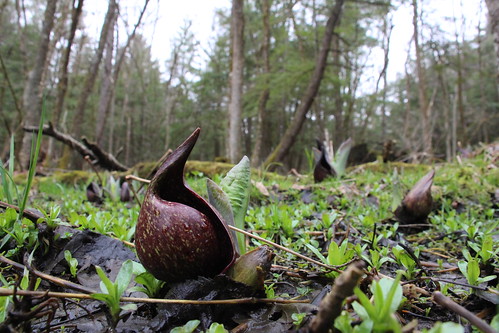By Chelsea Jandreau, Nature Educator
Audubon just wrapped up our last weekend of Audubon Lights, where colorful lights and scenes illuminated one of the trails so people can head out after dusk. My favorite statement and the one I heard more than any other by people on the trail that Sunday night was something along the lines of “Wow, the peepers are so loud!”
The peepers in question are more officially known as Spring Peepers. This small frog, with its brown camouflaged body, is difficult to find when they are silently hopping around the woods, but on a warm night the peeping sound they make is anything but quiet, especially when hundreds of them are gathered around ponds in early spring. Spring Peepers have abd appropriate name, in my opinion. The call is definitely a peep and for many, they are one of the most recognizable sounds of spring.
Spring’s arrival is signaled by an abundance of sights and sound. In the northeastern part of the United States, spring rarely comes all at once or in any sort of linear fashion. It comes and goes, dragging out the process in a series of starts and stops involving a rotating and constantly changing cast of plants, animals, temperature and precipitation.
I am usually terrible at choosing a favorite anything, but I am pretty sure that spring is my favorite season. Years of seasonal work have made me restless in April as my internal clock feels like it should be trying to fit everything I wanted to do in whatever location I was calling a temporary home into one final month before I prepare to move on to the next job, the next state, and the next adventure. It’s been a few years since this has been the cycle of my year, but I still feel the need for change around this time, and so leaning into the changes happening around me in nature helps to assuage some of that fidgety energy.
The Spring Equinox is widely known as the first official day of spring. However, often the first few days of warmth occur in February and we usually swing back around to winter weather in March or even April. If you start looking for and cataloging the signs of spring, you might spend months collecting all the sights, sounds and smells.
You might begin by noticing the return of some migratory birds and disappearance of others as they head even further north. The geese are usually early on as their general v-shaped formation flies overhead in a cacophony of honking. Later in March and throughout April, I watch as the geese begin nesting and laying eggs until eventually, at the end of spring the yellow, fluffy goslings are waddling around from pond to pond. Robins, who can be spotted hopping around as they search for bugs and worms, are an ubiquitous spring sight.

Spring is a time of many baby animals, from fawns to tadpoles. It is also the time of new growth for plants. Skunk Cabbage usually gets a head start. It generates its own heat and starts growing speckled purple buds in the middle of winter. In March, bushes and smaller trees will begin budding. Sometimes the buds are red like the Red Maple tree or have a purple tint. Usually the first bright green buds I notice are actually from a bush. I always get momentarily excited by the green until I remember that those bushes are all Honeysuckle and they are unfortunately invasive. Eventually in mid-April, the other plants catch up and more of that vibrant spring green is making an appearance. The planted daffodils bloom in March, and by the end of April, we have all sorts of yellows, purples, pinks and whites in bloom.
Many of these sights have accompanying sounds. I appreciate that spring is a multisensory experience. Things get a little louder outside. While the rustling of dead grasses left from winter and the calling of crows and Blue Jays are still prevalent, they are joined by a chorus of frogs and other birds that have just returned from their southern winter homes. Near me, the Spring Peepers and the high-pitched trill of American Toads are joined by a Killdeer at night. When morning comes, the starlings, robins, and seagulls over the lake take up the next verse.
Spring is a constantly changing landscape. As the ground thaws, refreezes and thaws again, mud is inevitable. Some places even go so far as to dub part of their spring as mud season. If winter was snowy, the snowmelt might also raise streams and contribute to fuller waterfalls. As spring continues to unfold, what other changes will you come across? If they haven’t already, you might see birds will fly back and forth to collect nesting materials, find spring flowers like violets and dandelions will pop up in yards, while Cuckoo Flowers and Trillium appear in more unkempt areas, and the trees will start fully leafing out. Keep an eye out and spring will continue to slowly unfold with returning friends and new surprises.
Audubon Community Nature Center builds and nurtures connections between people and nature. ACNC is located just east of Route 62 between Warren and Jamestown. The trails are open from dawn to dusk and birds of prey can be viewed anytime the trails are open. The Nature Center is open from 10 a.m. until 4:30 p.m. daily except Sunday when it opens at 1 p.m. More information can be found online at auduboncnc.org or by calling (716) 569-2345.


Recent Comments